Update your approach to soil health with the Haney test!
Different from traditional tests, the Haney test takes us deeper by assessing indicators such as soil respiration, water-soluble fractions of organic carbon and nitrogen.
Imagine soil as a living, breathing organism.
Yes, you heard right! Soil does breathe, and the extent of its respiration can tell you a lot about the health of the ecosystem under your feet.
Soil respiration is the process by which soil microorganisms consume organic material and produce carbon dioxide (CO2). This process is a key indicator of microbial activity and soil health. The more active the microorganisms, the more CO2 is produced, and therefore the more life is supported in your soil.
Why is it important?
- Nutrient cycle: Active soil promotes better nutrient cycling, making nutrients more readily available to plants.
- Formation of soil structure: Microbial activity contributes to the formation of soil aggregates, improving water permeability and aeration.
- Supporting plant health: Healthy soil can better resist disease and stimulate plant growth.
Measuring soil respiration can give us a realistic picture of its biological health and point out ways to improve it. Would you like to know what is breathing beneath the surface of your field?
Write to us
and we will find an opportunity
for cooperation


